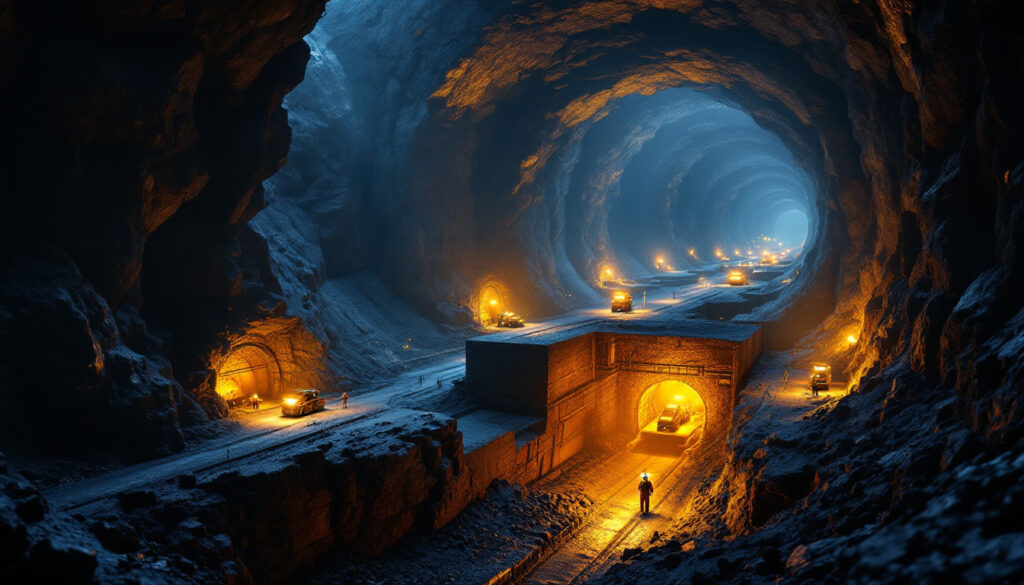Understanding India's New Underground Coal Mining Policy
India has taken a bold step to revolutionize its underground coal mining sector through a comprehensive new policy framework. The Ministry of Coal recently announced significant financial incentives aimed at making underground mining more economically viable while promoting sustainable extraction practices. These policy changes represent a strategic shift in India's approach to coal 2024 market review, balancing energy security needs with environmental considerations.
Key Policy Changes and Financial Incentives
The new policy introduces three major financial incentives for underground coal mining operations:
- Reduction in floor revenue share from 4% to 2% for underground coal mining projects, effectively halving the government's take from these operations
- Complete waiver of upfront payment requirements for underground mining operations, removing a significant barrier to entry
- Continuation of the existing 50% rebate on performance security for underground coal blocks
These incentives directly address the higher capital expenditure and longer gestation periods typical of underground mining operations. By reducing the initial financial burden, the government aims to attract more investment into this technologically advanced but capital-intensive mining method.
A Ministry of Coal statement emphasized that "incentivising underground mining drives efficiency, safety, and employment while ensuring ecological balance," highlighting the multi-faceted benefits expected from this policy shift.
Goals Behind the Policy Reform
The policy reform serves multiple strategic objectives for India's coal sector:
- Modernizing India's coal ecosystem through the adoption of advanced extraction techniques, including continuous miners, longwall systems, and remote sensing technologies
- Promoting sustainable development within the coal sector by encouraging methods with less surface disruption
- Encouraging private sector participation in underground mining by improving the economic equation
- Reducing financial barriers to entry for mining companies, particularly in light of the high initial investments required
- Creating an investment-friendly and innovation-driven coal sector that can compete globally
The Ministry noted that these incentives will "unlock underground mining potential" while simultaneously contributing to India's environmental goals by reducing the overall carbon footprint of coal extraction.
Why is Underground Coal Mining Important for India?
Underground coal mining represents a critical component of India's energy strategy, offering unique advantages that complement the country's existing opencast operations while addressing several key challenges.
Environmental Benefits of Underground Mining
The environmental case for underground mining is compelling:
- Significantly less surface disruption compared to opencast operations, preserving natural landscapes and ecosystems
- Reduced visible environmental footprint with minimal changes to surface topography
- Lower dust and particulate emissions to surrounding communities, improving air quality
- Better preservation of surface ecosystems and biodiversity as forests and natural habitats remain largely intact
- Potential for reduced water contamination issues with proper management techniques
The Ministry of Coal highlighted that underground mining causes "significantly less surface disruption" than traditional opencast methods, making it particularly valuable in environmentally sensitive areas or regions with high population density.
Economic and Strategic Advantages
Beyond environmental benefits, underground mining offers significant economic and strategic advantages:
- Access to deeper coal reserves (typically 300-600m depth) that are unavailable through surface mining methods
- Potential for higher-quality coal extraction from deeper seams, including premium coking coal
- Increased employment generation through labor-intensive operations that require skilled workers
- Contribution to India's energy security and self-reliance goals by tapping previously inaccessible domestic resources
- Diversification of coal extraction methodologies, creating a more resilient supply chain
A particularly compelling statistic underscores the strategic importance: India currently imports 85% of its coking coal, primarily from Australia. This heavy import dependence creates both economic vulnerability and energy security concerns that expanded underground coal mining could help address.
How Will These Incentives Transform India's Coal Sector?
The new incentives are expected to trigger a significant transformation in India's coal sector, driving technological innovation and contributing to a more sustainable mining landscape.
Technological Advancements Expected
The policy aims to accelerate the adoption of advanced mining technologies:
- Implementation of continuous miners and longwall systems for more efficient and safer extraction
- Deployment of remote sensing tools for improved safety monitoring and resource mapping
- Integration of AI-based safety mechanisms to protect underground workers and prevent accidents
- Development of specialized equipment customized for India's specific geological conditions
- Enhanced productivity through mechanization and automation of previously labor-intensive processes
These technological advancements will not only improve efficiency but also significantly enhance worker safety, traditionally a concern in underground operations.
Impact on Coal Production and Sustainability
The policy's broader impact on coal production and sustainability could be substantial:
- Potential increase in overall coal production capacity by accessing previously uneconomical reserves
- Improved extraction efficiency from deeper coal seams, maximizing resource utilization
- Reduced carbon emissions compared to traditional mining methods through more precise extraction
- Better balance between energy needs and environmental protection
- Support for India's transition to a more sustainable energy portfolio while maintaining energy security
This policy complements India's recent introduction of a 12% safeguard duty on certain steel imports, creating a more favorable environment for ESG mining transformation while reducing import dependency.
What Challenges Remain for Underground Coal Mining?
Despite the promising incentives, significant challenges remain for underground coal mining in India that will require careful navigation by industry stakeholders.
Technical and Operational Hurdles
The technical aspects of underground mining present unique challenges:
- Complex geological formations requiring specialized extraction techniques and expertise
- Higher safety requirements for underground operations, including ventilation, roof support, and emergency systems
- Need for skilled labor and specialized training programs in a sector with limited domestic experience
- Longer development timelines compared to surface mining, often 3-5 years before full production
- Higher initial capital expenditure despite incentives, with equipment costs typically 2-3 times that of comparable opencast operations
The Ministry acknowledges these "high capital investment and longer gestation periods" as fundamental challenges that the incentives aim to offset.
Market and Economic Considerations
Beyond technical hurdles, market realities create additional challenges:
- Competition with cheaper opencast mining operations (often ₹500/tonne vs. ₹1,200/tonne for underground mining)
- Global pressure to reduce coal dependency for climate goals, creating uncertainty about long-term demand
- Balancing production costs with market coal prices in an increasingly competitive global market
- Investment recovery over longer timeframes, typically 7-10 years compared to 3-5 for opencast mines
- Integration with India's renewable energy transition plans, which aim to increase non-fossil fuel sources
These economic factors explain why, despite having significant underground reserves, India has historically favored opencast mining for its lower costs and faster returns. However, thorough mining feasibility insights suggest that the new incentives could change this calculus.
How Does This Policy Connect to India's Broader Resource Strategy?
The underground mining incentives represent one component of India's comprehensive approach to resource security and energy independence.
Relationship to Other Mining Initiatives
The policy works in concert with several other strategic initiatives:
- Alignment with NMDC's exploration of coking coal assets in Indonesia and Australia, as confirmed by NMDC Chairman Amitava Mukherjee who stated that "explorations [abroad] are at various negotiation stages"
- Connection to India's import reduction goals, addressing the 85% dependency on imported coking coal
- Complementary to India's recent 12% safeguard duty on certain steel imports, creating a more cohesive minerals and metals strategy
- Part of the "Atmanirbhar Bharat" (self-reliance) initiative for critical minerals and resource security
- Strategic positioning in global mineral markets as India seeks to secure supply chains
These interconnected policies demonstrate a coordinated approach to strengthening India's position in global resource markets while reducing vulnerabilities.
Long-term Vision for India's Coal Sector
The policy reflects a nuanced long-term vision for India's coal sector:
- Gradual transition toward more sustainable extraction practices while maintaining energy security
- Balanced approach to meeting energy needs while reducing environmental impact
- Development of domestic expertise in advanced mining technologies, creating intellectual property and capabilities
- Reduction of dependency on coal imports through enhanced domestic production of high-quality coal
- Strategic positioning for future energy landscape changes, including potential carbon constraints
This approach acknowledges coal's continued importance to India's energy mix while preparing for a more environmentally conscious future. Additionally, the policy addresses the growing mining skills shortage by creating new opportunities for worker training and development.
FAQs About India's Underground Coal Mining Incentives
What specific financial benefits do the new incentives offer?
The policy provides three key financial benefits: a reduction in floor revenue share from 4% to 2%, complete waiver of upfront payment requirements, and continuation of the existing 50% rebate on performance security for underground coal blocks. Together, these incentives significantly improve the financial viability of underground mining projects.
How do underground coal mining operations differ from surface mining?
Underground mining involves extracting coal through tunnels and shafts beneath the earth's surface, causing minimal surface disruption, while surface mining removes overlying soil and rock to access coal seams, resulting in significant landscape alteration. Underground mining can access deeper reserves (300-600m) but requires specialized equipment and safety systems.
Will these incentives impact coal prices in India?
While the incentives aim to make underground mining more economically viable, their immediate impact on coal prices may be limited. Over time, increased production and efficiency could potentially help stabilize prices, particularly for high-quality coking coal currently sourced through imports.
How might these policies affect employment in India's mining sector?
Underground mining typically requires more workers than highly mechanized surface operations, potentially creating new employment opportunities, particularly for skilled workers trained in advanced mining technologies. The labor-intensive nature of underground operations could generate 1.5-2 times more jobs per ton of coal produced compared to opencast mining.
What environmental benefits does underground mining offer compared to opencast mining?
Underground mining significantly reduces surface disruption, preserves topsoil and vegetation, minimizes dust pollution, and generally has a smaller visible environmental footprint compared to opencast operations. This makes it particularly valuable in environmentally sensitive areas or regions with high population density where land rehabilitation costs and community resistance to mining can be significant challenges.
As the industry evolves, many companies are also exploring digital mining innovations to further enhance the efficiency and sustainability of underground operations.
Want to Discover the Next Major Mining Opportunity Before the Market?
Discovery Alert's proprietary Discovery IQ model delivers real-time notifications on significant ASX mineral discoveries, instantly transforming complex data into actionable insights for investors. Begin your 30-day free trial today at Discovery Alert and position yourself ahead of the market for potentially transformative returns.




